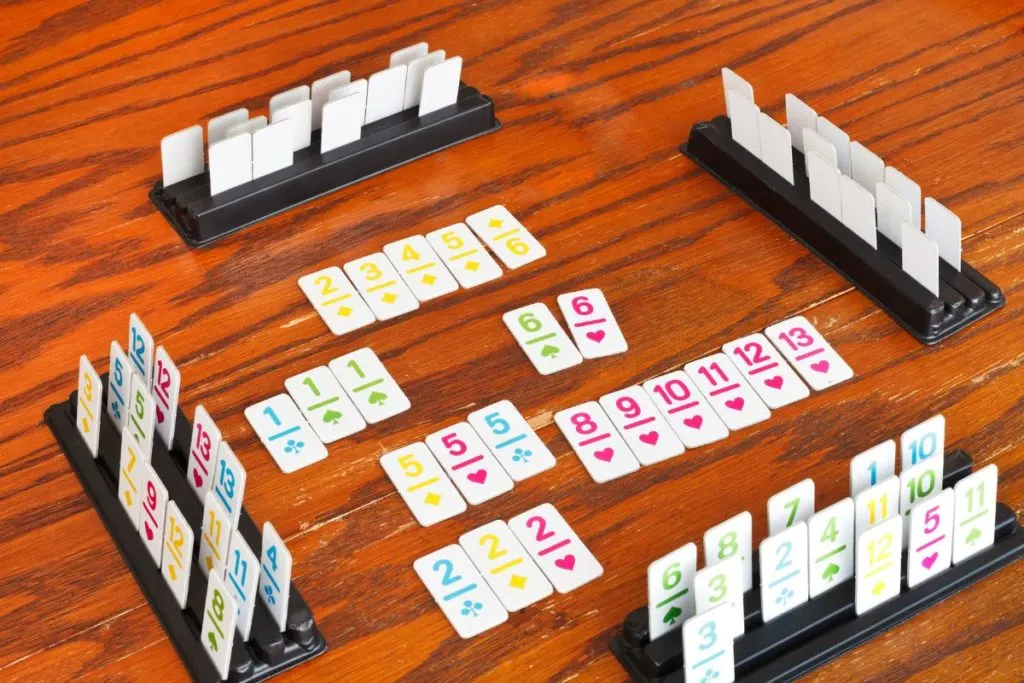*This post may contain affiliate links. As an Amazon Associate we earn from qualifying purchases.
Are you tired of losing every single game because you don’t understand the Rummikub instructions or game rules? Are you sick of feeling embarrassed every time you have to ask for clarification? Well, fear not because I’m here to help!
In this post, I’ll be breaking down all the rules in a way that’s easy to understand (even for people like me who aren’t exactly rocket scientists). By the end of this guide, you will not only know how to play Rummikub but you might even be a pro and finally beat your friends and family.

Setting Up the Rummikub Game
Before we can start playing, we have to set up the game board. This is super easy, just follow these steps:
- Open the box and pass out the tile racks. If you don’t have a game, I suggest stealing your neighbor’s. Just kidding! You can buy one online or at your local toy store.
- Shuffle and deal the tiles. To shuffle the tiles, just put them all in a big pile and mix them up like a deck of cards. Then, deal 14 tiles to each player (yes, even to your annoying little brother).
- Place the remaining tiles in the center of the table to create the “draw pile.”
And that’s it! Your game board is now set up and ready for some action.

The Objective When You Play Rummikub
The goal of the game is to be the first player to get rid of all your tiles by forming them into a combination of “sets” and “runs.” A set is a group of tiles with the same number, but different colors. For example, a set could be a red 9, a black 9, and an orange 9. A run is a group of tiles in the same color, but with consecutive numbers. For example, a run could be a blue 6, blue 7, and blue 8.
You can play your combinations onto the game board by either adding them to an existing set or run (after you are “out”), or by creating a new one of your own. Just make sure that each set and run has at least three tiles.
When you get rid of all your tiles, you win the game!

Gameplay Basics
Okay, so now that we know the objective of the game, let’s talk about how to actually play it.
How to Play Your First Turn
On your first turn, you have to play at least 30 points worth of tiles to get “out”. If you can’t do this, you have to keep drawing tiles from the draw pile on each of your turns until you can.
To play your tiles, simply place them on the table in front of you and arrange them into sets and runs. Once you are out with the 30 points played from your tile rack you can also manipulate the tiles that are already on the board to form new sets and runs.
You can also just add tiles to existing sets or runs if you wish on your turn.
Just make sure that each set and run has at least three tiles after you are done manipulating the tiles from yours and other people’s tiles that have been played on the table.
How to Add and Manipulate Tiles on the Board
To add a tile to a set or run on the board, it must be the same number as the other tiles in the set or the next consecutive number (up or down) in the run. For example, if there’s a red 9, blue 9, and orange 9 on the board, you can add a black 9 to it. Or, if there’s a blue 6, 7, and 8 on the board, you can add a blue 9 to the run.
Another way that you can manipulate the tiles on the board is by splitting a set or run into smaller sets and runs as long as each one has at least three tiles.
For example, if there’s a red 9, black 9, and orange 9 on the board, you can split them using the red 9 and black 9 and adding another 9 to make a complete set and then use the orange 9 in another set of 9s or use it in a run.
Or, if there’s a blue 6, 7, 8, and 9 on the board, you can split them into a blue 6, 7, 8 run and then use the blue 9 in a different set or run.
Just remember that you can only manipulate the tiles on your own turn, and you only have two minutes to manipulate all of the tiles that you want to on your turn. If you are unable to complete the manipulation (for whatever reason) and make complete sets and runs then you have to put the sets and runs back as they were and draw 3 tiles as a penalty.
As long as you are able to finish manipulating the tiles in your 2-minute time limit and you make sets and runs of at least 3 tiles you can do as much manipulating on your turn as you want. You can use your own tiles or any of your opponent’s tiles that have been played when you are manipulating on your turn.
Got it? Great, moving on.

Scoring (Joker and Tile Values)
In Rummikub, each tile is worth a certain number of points. The number tiles are worth their face value (for example, a 5 is worth 5 points), and the jokers are worth 30 points.
At the end of a round (when a person goes out) you will figure out your score.
To calculate your score, add up the points on all the tiles on your tile rack.
When you get rid of all your tiles first, you get a total of all the points left on all the other players’ racks. When you are left with tiles on your rack when someone else goes out they will get the total of your and the other player’s points.
Anyone with tiles left on their rack will get a negative score for those tiles while the winner of that round will get a positive score. So for example, if two people have 15 points worth of tiles left on their racks they would each have a -15 at the end of the round while the round winner would have a +30.
To win the game entirely you have to be the first person to get to a certain score (typically 200-300) that all of the players agree on before the game begins. If you are playing with more than 4 players you will want to increase this number but if you are playing with less you might want to lower it a bit.
It will typically take 3-5 rounds before a player will get enough points to be the game-winner but that can vary depending on the skill level of all of the players.
Joker Rules
Jokers are the wild cards of Rummikub and can be used to represent any tile in the game. They can be played in a set or run that you lay down or they can be added to an existing set or run to replace a tile if you wish.
Jokers are completely wild and can be used as any color or number. In older versions of the game, the Joker could only be replaced by a tile of the same number and color as it was first played as.
However, in recent editions of the Rummikub game, the rules have been simplified.
In the new Rummikub rules (found online) you can “free” a joker by manipulating tiles, playing a tile from your rack that allows you to replace that joker or really anything that makes it where the joker is able to be used.
The only rule in regards to how you can use the joker (according to the most recent Rummikub rules) is that you cannot pick it back up from the table and put it in your tile rack. Beyond that, you can use the joker tile as a legitimate wild and place it wherever you want.
So, make sure that everyone at the table agrees on the rules before you start playing since the people you are playing with might have played with either of these rules in the past.
Ending the Game
A game of ends when one player gets rid of all their tiles. That player is the winner of the round and gets a total score for that round equal to the total points left on all the other players’ racks.
Each player who lost that round will get a negative score equal to the points that they had left on their rack.
To keep track of the scores I would recommend grabbing a pen and paper or using your cell phone. That will make it a bit easier than everyone trying to remember their own scores.
Advanced Strategies
Okay, so now that you know the basics of Rummikub, let’s talk about some advanced strategies to help you dominate your opponents.
First and foremost, always try to keep your options open. This means holding onto tiles that can be used in multiple sets and runs, rather than getting rid of them right away.
I would also recommend holding onto a tile or set that you can play on your next turn if possible (and if you aren’t in the late stages of the game). Doing this will keep you from having to draw a tile on your next turn if you aren’t able to play anything (since you can play that other tile or set you held onto).
It’s also a good idea to try to manipulate the tiles on the board as much as possible. This will give you more opportunities to play your own tiles and block your opponents from playing theirs.
And finally, don’t be afraid to use jokers wisely. They can be a game-changer if used correctly, so don’t be afraid to play them early on. Just remember when you play a joker early you are at risk of giving your opponents many opportunities to use them as well.
Rummikub Variations
There are a few variations of Rummikub that you can try out to mix things up. Here are a few popular ones:
- Playing with 2-3 players: In this version, each player gets 16 tiles and the game is played as normal.
- Playing with 5-6 players: In this version, each player gets 11 tiles and the game is played as normal.
- Playing with 7 or more players: In this version, the game is played with teams of 2-3 players. Each player gets 11 tiles and the team with the highest score wins.
How do you shuffle and deal the tiles in Rummikub?
To shuffle the tiles, just put them all in a big pile and mix them up like a deck of cards. Then, deal 14 tiles to each player (yes, even to your annoying little brother).
Can you rearrange tiles on the board during your turn in Rummikub?
Yes, you can manipulate/rearrange any of the tiles on the board on your own turn in any way that you wish. As long as your turn ends with all of the tiles on the table being in sets or runs of three then you can rearrange as much as you want.
How do you use jokers in Rummikub?
Jokers can be used to represent any tile in the game and can be played in a set or run that you lay down or they can be added to an existing set or run on the board.
Final Thoughts
Well, that about covers it for the Rummikub rules! I hope this guide was helpful and that you feel more confident about your skills than you did when you started this article.
Just remember to keep your options open, manipulate the tiles on the board, and use jokers wisely, and you’ll be well on your way to becoming a pro.
